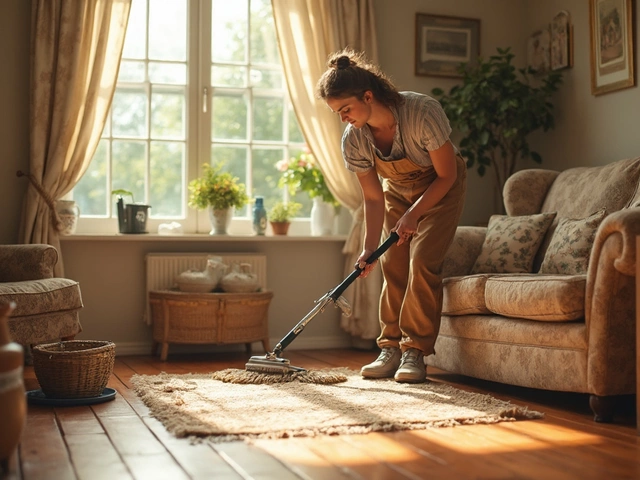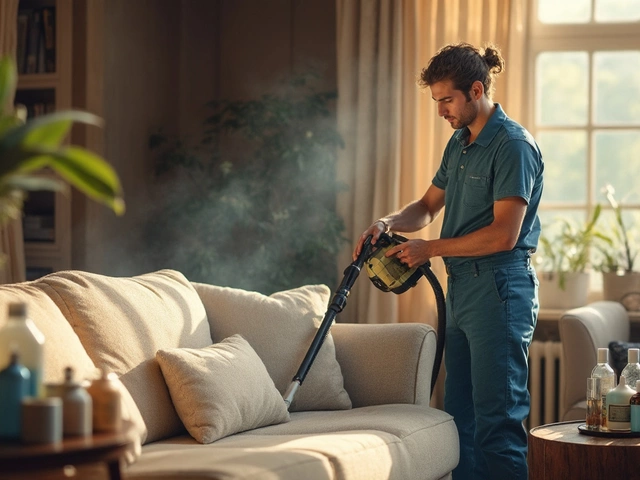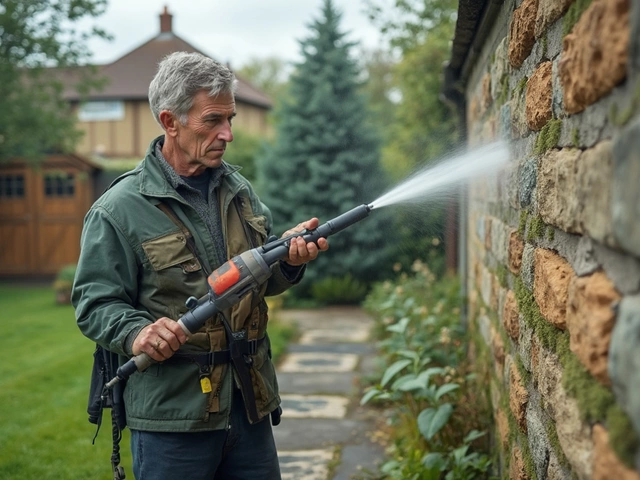You've just spent your afternoon scrubbing your couch, hoping to restore its former glory, only to find it looking even worse than before. It's a disheartening scene: blotchy stains, uneven hues, and the faint whiff of too much detergent hanging in the air.
This isn't an uncommon experience, and it can leave many puzzled about where they went wrong. Could it be the choice of cleaning supplies? Or maybe the method was off? Understanding these common pitfalls is key to reversing the damage and achieving a spotless couch.
We'll unravel why this happens more often than anyone would like, and equip you with the knowledge needed to perfect your upholstery cleaning game.
- Common Mistakes in Upholstery Cleaning
- The Role of Soap Residue
- Deeply Embedded Dirt and Stains
- Effective Cleaning Techniques
- Maintaining a Spotless Couch
Common Mistakes in Upholstery Cleaning
One of the most perplexing issues in upholstery cleaning is finding your couch looking worse after a thorough scrub. This often happens because of a few common mistakes that many people make. Although cleaning instructions might sound straightforward, there's often more than meets the eye. One error is using inappropriate cleaning solutions. Many commercial cleaners contain harsh chemicals that can damage your fabrics or leave behind residues, leading to more dirt attraction in the long run. It's important to select a cleaner that suits the material of your couch.
Another frequent mistake is over-wetting. Over-wetting occurs when too much water is used during the cleaning process, which can seep into the cushions and padding. As the couch dries, this extra moisture can bring dirt to the surface, leaving unsightly marks. Moreover, excessive moisture can sometimes lead to a persistent damp smell or even contribute to the growth of mold and mildew. Ensuring that your cleaning process uses water sparingly and focuses on targeted areas will help avoid this pitfall.
Using the Wrong Tools
Beyond the moisture issue, the tools themselves can also be a source of trouble. A lot of people tend to scrub too vigorously, especially when dealing with stubborn stains. This harsh scrubbing can wear out fabric fibers and spread stains rather than remove them. Soft-bristled brushes or a microfiber cloth can be much more effective and gentle on your couch. However, it's crucial to follow a consistent cleaning direction to ensure uniformity.
"Choosing the right approach for your furniture's fabric is as essential as choosing the right detergent," explains furniture expert Samantha Green.
Another tool-related mistake is the improper use of vacuum cleaners. Many skip the vacuuming step altogether, overlooking how it can help remove surface dirt before deeper cleaning. However, using a vacuum without the proper attachments can tear or pull on delicate fabrics. Ensuring that fittings are secure and gentle can prevent unnecessary wear and tear.
Ignoring Fabric Type Instructions
Finally, failing to pay attention to the manufacturer's cleaning instructions can lead to more harm than good. These guidelines are there to help prolong the life of your furniture, and ignoring them might leave couches looking shabby and worn before their time. Always check for the best practices regarding water temperature, types of detergents, and drying recommendations for your specific fabric type. If unsure, testing a small, inconspicuous area can be a life-saver in knowing how your furniture will respond.
Addressing these common upholstery cleaning mistakes can dramatically improve the outcome of your cleaning efforts. By taking the time to understand the needs of your couch and avoiding these pitfalls, you can help ensure that your furniture remains a beautiful centerpiece in your home.
The Role of Soap Residue
Soap residue is a sneaky culprit when it comes to upholstery problems, often disguising itself as a helpful cleaning agent while leaving behind a trail of trouble. When you clean your couch, the soap is designed to break down grime and lift dirt from the fabric. However, if not rinsed thoroughly, the residual soap film can attract dirt and dust particles like a magnet. This can create a layer of grime that quickly accumulates, making your newly cleaned couch appear dirty just a few days later.
Think about every time you've washed your hair. The leftover shampoo in your hair makes it feel greasy sooner, doesn't it? Your couch fabric works similarly. A common mistake people make is using too much detergent, believing the more the better. In fact, over-soaping without a proper rinse is one major reason for worsening the appearance of your couch after cleaning. Rinsing becomes tricky, especially with materials like microfiber or cotton blends, as lingering soap can be tough to extract fully. This doesn’t just make the surface look grimy; over time, soap scum can harm fabric fibers, degrading their integrity.
A study from the Professional Upholstery Association revealed that up to 70% of homeowners who clean their furniture themselves use an incorrect ratio of cleaning solution to water. The improper balance can create a soapy residue problem that’s hard to notice until the fabric fully dries. This is why consistency in the solution ratio is crucial. As acclaimed cleaning expert Martha Stewart once mentioned,
“The right cleaning mixture is essential. Less is often more when it comes to detergents, especially on delicate surfaces like your couch.”
Now, you might ask, how do I avoid this sticky predicament? Well, opting for detergent-free cleaning solutions or those specifically designed for upholstery cleaning can significantly reduce residue issues. When using homemade solutions, always ensure they're fully dissolved in water before application. Utilizing steam cleaners can also help, as the steam effectively lifts both dirt and detergent without leaving residue. Remember, it’s always prudent to perform a small fabric test in an inconspicuous area to ensure the solution doesn't leave any undesirable effects.
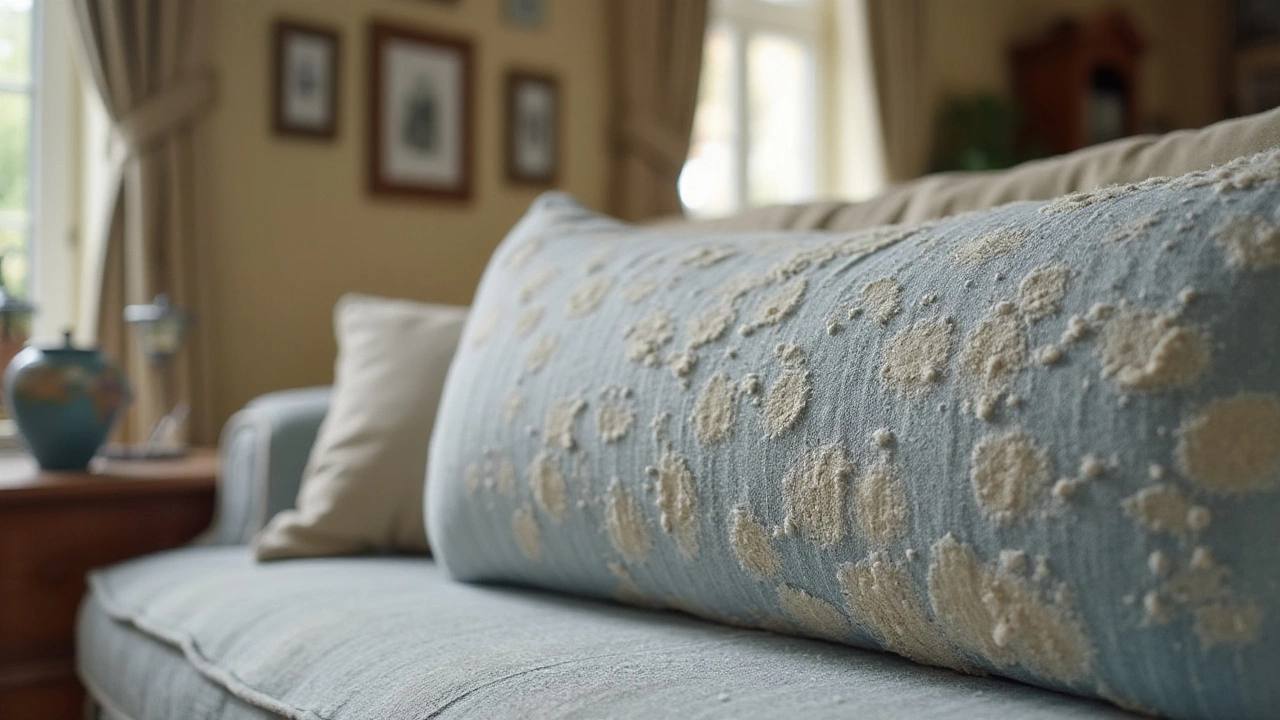
Deeply Embedded Dirt and Stains
When it comes to upholstery cleaning, one of the biggest hurdles homeowners face is dealing with deeply embedded dirt and stains. These hidden layers of grime tend to accumulate over time as we enjoy our beloved couches, leaving marks that are hard to notice until they start to appear on the surface. The cozy movie nights and family gatherings on our couch might bring joy, but they also invite mud, food particles, and invisible oils to nestle within the fabric. Over time, these particles sink deeper, escaping the reach of casual cleaning efforts.
The irony here is that a surface clean often does not just fail to remove these entrenched specks, but highlights them. When water or certain cleaning agents come in contact with these entrenched particles, they can inadvertently draw up the dirt to the surface. It's a stark reminder that what lies beneath the surface is often the real issue. This is particularly true if you've ever noticed that the dirt seems to reappear shortly after cleaning, looking somewhat like a ghost from gatherings past.
Consider the type of fabric your couch is adorned with; different materials have varied ways of interacting with spills and stains. For instance, natural fibers like cotton or linen can act like sponges, sipping up spills and locking in dirt hitchhikers. Even highly durable synthetics are not immune to persistent stains, thanks to their complex weave which can trap debris stubbornly. Because of these factors, cleaning such stains becomes not just an act, but a calculated intervention that seeks out the problem at its roots. This nature of dirt entrenchment signals that what you may need is not just a regular surface clean, but deeper treatment that handles these stubborn particles effectively.
A step towards addressing this deep-rooted menace is understanding that standard vacuuming, while essential, is merely your opening gambit. To thoroughly clean these persistent stains, many homeowners find success using steam cleaning or professional deep cleaning services, both known for their ability to penetrate deep into fabric fibers. This method typically involves high-temperature steam to soften and extract dirt, offering a gentle approach that doesn’t harshly agitate the fabric. Additionally, steam possesses an inherent sanitizing property, an added bonus for any household looking to tackle germs alongside grime.
“Deep cleaning helps to not only improve the aesthetics of your couch but can lengthen its lifespan,”says a leading expert in textile maintenance.
When considering DIY efforts, opting for formulated, enzyme-based cleaners can also help break down organic stains and odors at a molecular level. Following this with a dry cleaning method can prevent residue build-up, especially when using DIY solutions. It's often overlooked, but blotting instead of scrubbing is vital to not embedding dirt further. Remember, consistency is key. Quarterly deep cleans can help stay ahead of potential dermal dirt integration. This ensures that you maintain a lush and inviting sofa year-round.
The next time you spot a reemerged stain, know that it isn't a sign of neglect or inadequate cleaning. Instead, it's an indication that your couch is asking for deeper care. And by tuning into these signals, your efforts in fabric care and focus on detail can transform your upholstered friend into both a visual delight and central feature of your living room landscape.
Effective Cleaning Techniques
When it comes to restoring and maintaining the sparkle in your upholstery, especially your beloved couch, adopting the right cleaning techniques can make all the difference. The fabric on furniture tends to hold onto dirt, grime, and even stains that are often missed during quick cleaning sessions. To properly revitalize your furniture, it is crucial to start by understanding the fabric type you are dealing with. This determines your cleaning materials and strategy. For instance, natural fibers like cotton might require gentler products compared to synthetic fibers, which can handle a bit more robust cleaning solutions. Performing a spot test on a hidden area of the couch is always wise to avoid discoloration or damage.
Another effective approach is the use of steam cleaning. Steam can penetrate deep into the fibers of your couch, breaking down dirt and grime without the need for harsh chemicals. This method is especially useful for those concerned about the environment or for anyone who has allergies, as it minimizes the use of chemical detergents. Regular vacuuming should not be overlooked either; it plays a critical role in preventing dust and allergens from embedding deeply into the fabric. It's surprising how often vacuuming is neglected, yet it lays the groundwork for a more thorough cleaning process.
For tougher stains, consider a simple homemade solution of lukewarm water, a mild detergent, and vinegar. This combination is effective in loosening up stains without damaging the upholstery. Be careful not to soak the fabric too much, as excessive moisture can lead to mold or mildew. Gently blotting the stain rather than scrubbing can prevent the stain from spreading or the fabric from getting damaged. It's fascinating how such an uncomplicated mixture can produce effective results.
"A well-maintained couch not only enhances the aesthetic of a room but also extends the furniture's life span," notes a cleaning expert from Clean & Simple Magazine. Taking a systematic approach and ensuring you've covered all the bases can lead to impressive transformations.
Adopting a regular cleaning schedule is also key. Just like any household maintenance, having a routine helps maintain a fresher and cleaner couch. Lastly, remember that professional cleaning services can sometimes be the best option, especially for high-value or particularly filthy furniture. These services offer techniques and equipment that aren't available to the average homeowner, ensuring a more thorough clean. With consistent care and the right methods, your couch can continue to be a comfortable and inviting centerpiece in your living room for years to come.
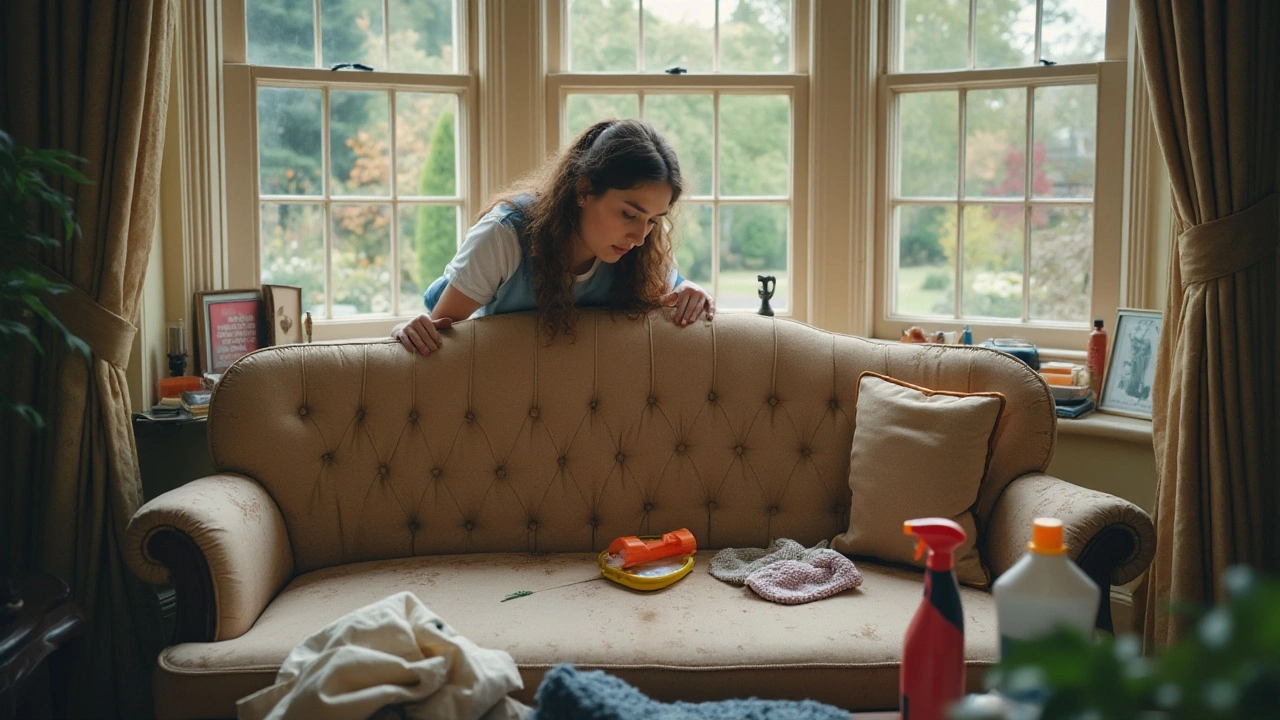
Maintaining a Spotless Couch
Keeping your couch in pristine condition is not a one-time task but an ongoing process that requires regular attention and the right techniques. First and foremost, understanding the fabric of your couch is essential. Different fabrics, from suede and leather to microfiber, need tailored cleaning methods. While suede may demand gentle dry brushing, leather requires moisturizing treatments to prevent cracking and fading. Microfiber, meanwhile, might benefit from simple homemade solutions like water and a drop of dish soap. Identifying your fabric type ensures you're using methods that won't harm your upholstery.
A routine cleaning schedule can also work wonders in maintaining the cleanliness of your couch. Plan to vacuum your couch weekly, using an attachment to reach the nooks and crannies where crumbs and dust often gather. This step alone can significantly extend the life of your couch by preventing abrasive dirt from wearing down the fabric. For deeper cleaning, which should be done every few months, consider using steam cleaners. These can lift stubborn dirt and sanitize your couch simultaneously without harsh chemicals, providing a deeper clean that simple vacuuming can't achieve.
"Regular maintenance is key to extending the life of upholstery. By integrating simple habits into your cleaning routine, you can effectively preserve both the appearance and longevity of your furniture," says Laura Myers, a renowned expert in fabric care.
Another effective strategy involves the prompt handling of spills and stains, which are inevitable over time. The faster you can address these mishaps, the less likely they are to become permanent blemishes. Keep an upholstery-safe stain removal kit on hand, so you're always prepared. Gently blot the affected area immediately with a clean, dry cloth to absorb as much liquid as possible before applying any cleaning agents. Remember, rubbing can push the stain deeper, making it more difficult to clean effectively.
For those particularly invested in maintaining a spotless couch, applying fabric protection spray can be a wise move. These sprays create a protective barrier that helps repel liquids, making spills easier to blot out before they can stain the fabric deeply. However, it's crucial to apply these products following the manufacturer's instructions to avoid any potential damage or discoloration.
A consistent habit that can make a significant difference is rotating and flipping your couch cushions regularly. This practice not only ensures even wear but also prevents one side from becoming flattened or misshapen. While doing this, take the opportunity to inspect your couch for any signs of wear or areas that may need specific attention, such as seams that are starting to fray.
If you're looking to elevate the aesthetic integrity of your living space, consider redecorating with slipcovers. These protective covers can keep your couch clean while allowing you to refresh your décor. Opting for machine-washable slipcovers can make it easy to regularly wash dirt and dust away, preserving your couch underneath. Not only are slipcovers practical, but they also afford you the creative freedom to change the look of your space with different colors and textures as the seasons change.

